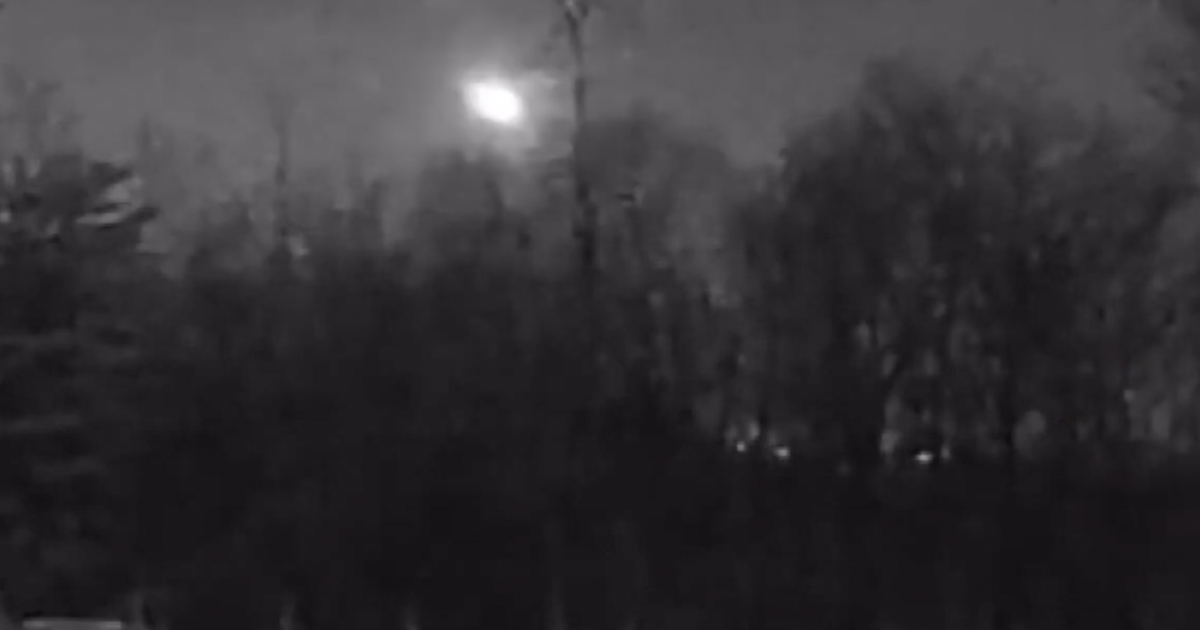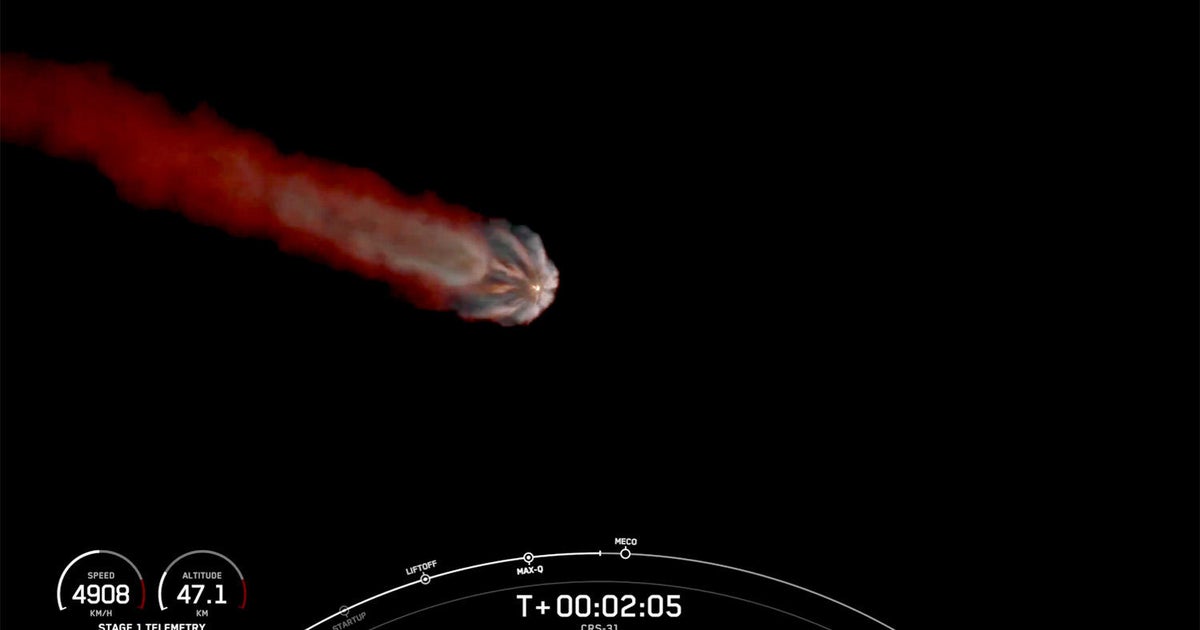CBS News
Massive fireball lights up night sky across large swath of U.S.

A glittering fireball ignited evening skies over vast sections of the eastern United States and parts of Canada on Wednesday night, as it entered earth’s atmosphere and promptly burned up. The dazzling display was reported by more than 200 observers on the ground in 11 U.S. states and Ontario, according to data collected by the American Meteor Society.
Most people who spotted the meteor Wednesday night reported seeing it between 6:45 and 7 p.m. EST, the data shows, and most individual sightings lasted from 1 to 7 1/2 seconds. But a handful of reports indicated that the falling space rock lingered for quite a while longer than that before disappearing, with one report out of Augusta, West Virginia, and another out of Front Royal, Virginia, saying the fireball was visible for as long as 20 seconds.
Some sightings were particularly vibrant even if they were brief. Ring camera footage shared online by Lyndon, Virginia, resident Donald Bradner showed a bright burst of light zooming through skies over nearby Maryland. The footage was obtained by CBS affiliate WUSA-TV. Additional sightings Wednesday night happened farther north in Pennsylvania and into the Midwest, with at least one documented in Westlake, Ohio, and another in Southfield, Michigan, according to the news station.
“Meteors are harmless and never hit the surface of the earth. Meteorites, on the other hand, do hit the earth before they burn up,” said Topper Shutt, a meteorologist at WUSA, in a report late Wednesday on the latest sightings.
Scientists have estimated that about 48 1/2 tons of meteoritic material falls on Earth every day, according to NASA. When a space rock enters the atmosphere on its own and burns up, it’s called a meteor, or shooting star. Those that are especially bright — sometimes appearing even brighter than Venus — it’s called a fireball.
The space rocks are called meteoroids before descending down toward earth, and they can vary greatly in size. Some are as small as a grain of dust, while others are as large as an asteroid. Most of them are pieces that broke off of larger objects in space, like comets or even the moon and other planets. Meteoroids can be rocky, metallic or a combination of both, according to NASA.
One exceptionally bright fireball was seen by hundreds across the mid-Atlantic region of the U.S. last September. NASA said at the time that the fireball appeared as bright as a quarter moon, and scientists determined that the original meteoroid from which it came was a small fragment of an asteroid. The asteroid may have come from the Asteroid Belt between Mars and Jupiter, they said.
CBS News
A study to devise nutritional guidance just for you

It’s been said the best meals come from the heart, not from a recipe book. But at this USDA kitchen, there’s no pinch of this, dash of that, no dollops or smidgens of anything. Here, nutritionists in white coats painstakingly measure every single ingredient, down to the tenth of a gram.
Sheryn Stover is expected to eat every crumb of her pizza; any tiny morsels she does miss go back to the kitchen, where they’re scrutinized like evidence of some dietary crime.
Stover (or participant #8180, as she’s known) is one of some 10,000 volunteers enrolled in a $170 million nutrition study run by the National Institutes of Health. “At 78, not many people get to do studies that are going to affect a great amount of people, and I thought this was a great opportunity to do that,” she said.
CBS News
It’s called the Nutrition for Precision Health Study. “When I tell people about the study, the reaction usually is, ‘Oh, that’s so cool, can I do it?'” said coordinator Holly Nicastro.
She explained just what “precise” precisely means: “Precision nutrition means tailoring nutrition or dietary guidance to the individual.”
The government has long offered guidelines to help us eat better. In the 1940s we had the “Basic 7.” In the ’50s, the “Basic 4.” We’ve had the “Food Wheel,” the “Food Pyramid,” and currently, “My Plate.”
CBS News
They’re all well-intentioned, except they’re all based on averages – what works best for most people, most of the time. But according to Nicastro, there is no one best way to eat. “We know from virtually every nutrition study ever conducted, we have inner individual variability,” she said. “That means we have some people that are going to respond, and some people that aren’t. There’s no one-size-fits-all.”
The study’s participants, like Stover, are all being drawn from another NIH study program called All Of Us, a massive undertaking to create a database of at least a million people who are volunteering everything from their electronic health records to their DNA. It was from that All of Us research that Stover discovered she has the gene that makes some foods taste bitter, which could explain why she ate more of one kind of food than another.
Professor Sai Das, who oversees the study at Tufts University, says the goal of precision nutrition is to drill down even deeper into those individual differences. “We’re moving away from just saying everybody go do this, to being able to say, ‘Okay, if you have X, Y and Z characteristics, then you’re more likely to respond to a diet, and somebody else that has A, B and C characteristics will be responding to the diet differently,'” Das said.
It’s a big commitment for Stover, who is one of 150 people being paid to live at a handful of test sites around the country for six weeks – two weeks at a time. It’s so precise she can’t even go for a walk without a dietary chaperone. “Well, you could stop and buy candy … God forbid, you can’t do that!” she laughed.
While she’s here, everything from her resting metabolic rate, her body fat percentage, her bone mineral content, even the microbes in her gut (digested by a machine that essentially is a smart toilet paper reading device) are being analyzed for how hers may differ from someone else’s.
Nicastro said, “We really think that what’s going on in your poop is going to tell us a lot of information about your health and how you respond to food.”
CBS News
Stover says she doesn’t mind, except for the odd sounds the machine makes. While she is a live-in participant, thousands of others are participating from their homes, where electronic wearables track all kinds of health data, including special glasses that record everything they eat, activated when someone starts chewing. Artificial intelligence can then be used to determine not only which foods the person is eating, but how many calories are consumed.
This study is expected to be wrapped up by 2027, and because of it, we may indeed know not only to eat more fruits and vegetables, but what combination of foods is really best for us. The question that even Holly Nicastro can’t answer is, will we listen? “You can lead a horse to water; you can’t make them drink,” she said. “We can tailor the interventions all day. But one hypothesis I have is that if the guidance is tailored to the individual, it’s going to make that individual more likely to follow it, because this is for me, this was designed for me.”
For more info:
Story produced by Mark Hudspeth. Editor: Ed Givnish.
“Sunday Morning” 2024 “Food Issue” recipe index
Delicious menu suggestions from top chefs, cookbook authors, food writers, restaurateurs, and the editors of Food & Wine magazine.
CBS News
A new generation of shopping cart, with GPS and AI

Watch CBS News
Be the first to know
Get browser notifications for breaking news, live events, and exclusive reporting.
CBS News
“All hands on deck” for Idaho’s annual potato harvest

Watch CBS News
Be the first to know
Get browser notifications for breaking news, live events, and exclusive reporting.











